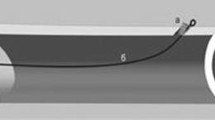Abstract
Pure titanium rods plasma-spray coated with hydroxyapatite (HA) or porous titanium (Ti) of controlled roughness were implanted bilaterally in the distal femur of Sprague-Dawley rats to compare the extent of bone growth on the two types of coating. The relevance of other factors, like mechanical stability and biological adaptation of the bone to the insertion of a foreign body implant, were investigated in femora which were over-reamed (absence of primary fit) or reamed without insertion of the rod. Continuous tetracycline labeling for the first 30 days and for the last 2 weeks in the 90-day group was performed; histological/histometric, fluorescence and microangiographic studies were carried out on serial sections of the implanted and control femora. In the group of stable implants, HA-coated rods showed 90% integration versus 53% with Ti-coated implants (P < 0.001); in over-reamed implants neither surface bone growth nor endosteal fixation occurred, and both types of rods were surrounded by a thick layer of connective tissue. The study documented early adhesion of osteoblasts and direct deposition of bone matrix on the substrate, while on spongious titanium osteogenesis was observed only in proximity to the surface. Remodeling of the reactive, primary bone to mature, lamellar bone took the form of a capsule surrounding the implants and radial bridges connecting the latter to the endosteal surface. The number, height and thickness of these bridges appeared to be the factors determining implant stability, rather than the extent of the bony capsule on the perimeter of the implant. Integration was a function not only of mechanical conditions and surface geometry, but also of the biological response of the whole bone to changes in the vascularization pattern. The reported phenomena can be seen more easily in experimental models involving small rodents because of their fast bone turnover and revascularization, but it is expected that they take place, even at a lower speed, in clinical situations like cementless stems of total hip replacement.
Similar content being viewed by others
Author information
Authors and Affiliations
Additional information
Received: 22 August 1995
Rights and permissions
About this article
Cite this article
Pazzaglia, U., Brossa, F., Zatti, G. et al. The relevance of hydroxyapatite and spongious titanium coatings in fixation of cementless stems . Arch Orth Traum Surg 117, 279–285 (1998). https://doi.org/10.1007/s004020050247
Issue Date:
DOI: https://doi.org/10.1007/s004020050247




